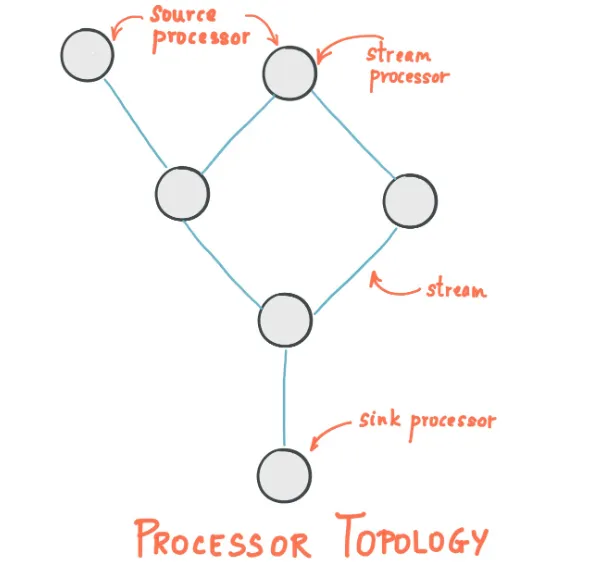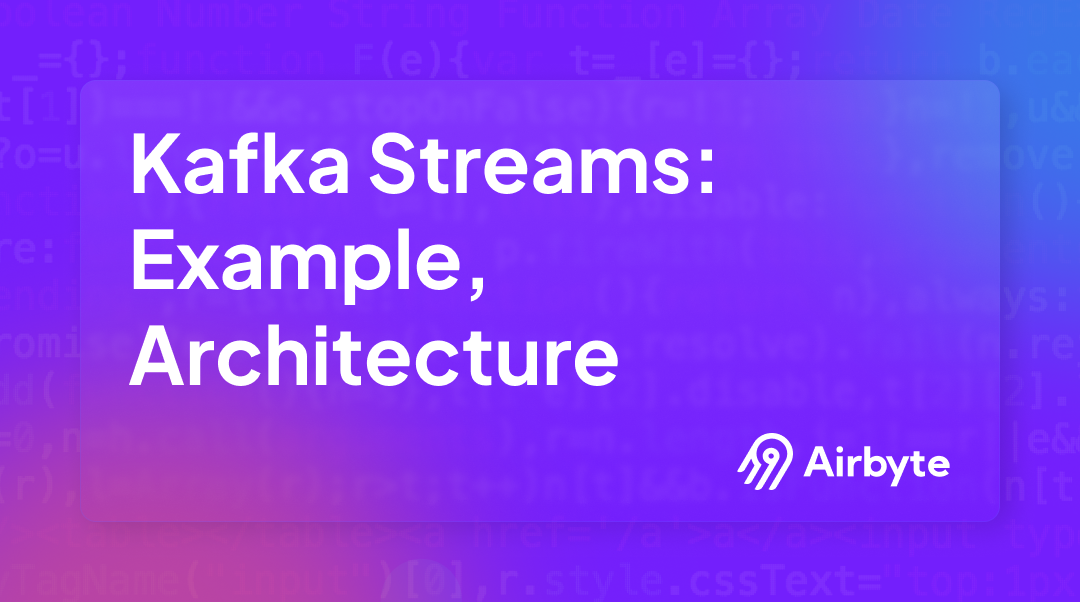What is Kafka Streams: Example & Architecture
Summarize this article with:
✨ AI Generated Summary
Apache Kafka has become essential for real-time data processing, with Kafka Streams enabling continuous, exactly-once analytics and scalable stream-processing applications. Key advancements in Kafka 4.0 include the removal of ZooKeeper via KRaft, enhanced consumer group protocols, versioned state stores, and AI-powered optimizations, improving performance, fault tolerance, and operational stability.
- Kafka Streams supports stateful operations, low-latency queries, and seamless horizontal scaling without code changes.
- Integration with AI/ML enables real-time anomaly detection, dynamic model retraining, and Retrieval-Augmented Generation (RAG) pipelines.
- Serverless Kafka and data-integration tools like Airbyte reduce costs and simplify ingestion of structured and unstructured data.
- Security updates in 2025 require upgrading to Kafka 3.9.1/4.0.0 to address critical vulnerabilities.
- Kafka Streams is widely adopted, powering use cases such as fraud detection, IoT telemetry, personalization, and dynamic pricing across 150,000+ organizations.
Apache Kafka is now a core part of modern data systems as organizations work to manage rapidly growing data and deliver real-time insights. Traditional batch processing cannot keep pace, making stream processing essential. Kafka Streams, the platform’s built-in processing library, allows teams to analyze events as they happen, identify patterns in real time, and trigger automated actions. This is vital for use cases like financial transactions, IoT data, and user behavior analytics where delays can lead to missed opportunities or hidden risks.
The adoption of Kafka has reached unprecedented scale, with over 150,000 organizations now using Kafka worldwide and more than 80% of Fortune 100 companies incorporating Kafka into their data infrastructure. The event stream processing market has grown from $1.45 billion in 2024 to a projected $1.72 billion in 2025, representing an impressive 18.7% compound annual growth rate.
Modern Kafka Streams implementations have evolved significantly, incorporating AI-powered optimization, cloud-native deployment patterns, and advanced state-management capabilities. This guide explains how to leverage Kafka Streams' full potential for real-time data processing.
What Is Kafka Streams and How Does It Work?
Kafka Streams is a client library for building stream-processing applications and microservices on top of Apache Kafka. It:
- Consumes data from Kafka topics
- Performs analytical or transformation operations
- Publishes processed results to another Kafka topic or external system
Unlike batch systems, Kafka Streams processes data continuously as it arrives, enabling real-time analytics with exactly-once guarantees. With the release of Kafka 4.0, significant architectural improvements have been introduced, including the complete elimination of Apache ZooKeeper dependency, with KRaft (Kafka Raft) mode becoming the default and only supported metadata management system. Recent innovations have also introduced versioned state stores for temporal look-ups and Interactive Query v2 (IQv2) for direct, low-latency state queries.
Kafka Streams applications start on a single node and scale horizontally simply by adding more instances—no code changes required. Performance testing has demonstrated that Kafka can handle up to 2 million writes per second on a three-machine cluster configuration, showcasing its ability to manage high-throughput scenarios effectively.
Key Features of Kafka Streams
- Lightweight client library—no separate cluster required
- No external dependencies other than Kafka
- At-least-once or exactly-once semantics
- Event-time and processing-time handling with watermarks
- Stateful operations (aggregations, joins, windowing)
- DSL and low-level Processor API
- Built-in fault tolerance and automatic state recovery
- Versioned state stores for temporal queries
- Interactive Query v2 (REST-based state queries)
- Enhanced foreign key extraction capabilities through KIP-1104 improvements
- ProcessorWrapper interface via KIP-1112 for seamless custom logic injection
- AI-powered optimization that dynamically adjusts routing and resources
How Kafka Streams Processing Topology Works
A topology is a directed acyclic graph of processors and state stores that defines how data flows through your application.

Source Processor
Entry point. Consumes records from one or more topics, deserializes them, and forwards downstream.
Sink Processor
Exit point. Receives transformed records and writes them to topics or external systems.
Upstream processors feed data to downstream processors; downstream processors consume data from upstream ones.
Architecture of Kafka Streams

Stream Partitions & Tasks
- Partition – ordered sequence of records within a topic.
- Task – unit of parallelism; owns its own topology instance and state stores.
Threading Model
Configure the number of stream threads per application instance; threads run tasks independently—no shared state, no locking.
Local State Stores
Local key-value stores (now optionally versioned) enable low-latency stateful operations. Changelog topics replicate state for recovery.
Fault Tolerance
On failure, tasks restart on another instance; state stores are rebuilt from changelog topics, resuming exactly where they stopped. The new KRaft architecture in Kafka 4.0 eliminates traditional bottlenecks associated with ZooKeeper coordination, enabling Kafka clusters to support larger numbers of partitions and topics that Kafka Streams applications commonly require for parallel processing.
Exactly-Once Processing Semantics (EOS)
Exactly-once guarantees ensure no duplicates and no data loss—even during failures.
How It Works
- Idempotent producers prevent duplicate writes.
- Transactions group reads, state updates, and writes atomically.
- Read-committed consumers expose only committed data downstream.
Configuration (Java)
EOS adds ~5–10 % overhead versus at-least-once but is essential for mission-critical workloads. Organizations using time-windowed aggregations in their streaming applications can increase their operational efficiency by up to 30% through these enhanced processing capabilities.
AI & Machine Learning in Kafka Streams
AI-Powered Stream Processing
Apache Flink has emerged as the premier choice for organizations seeking robust and versatile frameworks for continuous stream processing, with its ability to handle complex data pipelines with high throughput, low latency, and advanced stateful operations solidifying its position as the de facto standard for stream processing. As Flink adoption grows, it increasingly complements Apache Kafka as part of the modern data streaming ecosystem.
Real-Time RAG Pipelines
Kafka Streams powers Retrieval-Augmented Generation flows:
- Convert user queries to embeddings.
- Query vector DBs.
- Augment prompts for large language models (LLMs).
- Return responses with sub-second latency, keeping context in stream state.
Dynamic Model Retraining
Change Data Capture (CDC) streams trigger incremental retraining, while Kafka Streams state stores act as real-time feature stores—eliminating training/serving skew.
Cloud-Native & Serverless Deployments
Serverless Kafka
- AWS MSK Serverless – auto-scales, pay-per-throughput.
- StreamNative Cloud – separates compute/storage, faster rebalances.
The democratization of Kafka through competitive market offerings has contributed to cost benefits, with some specialized cluster types offering up to 90% cost reduction for specific use cases like high-volume log analytics.
Kubernetes Operators
Operators (e.g., Cloudera Streams Messaging) manage rolling upgrades, PVCs, and security for stateful streaming workloads.
Zero-ETL Architectures
Confluent Tableflow materializes Kafka topics into Iceberg tables automatically. Data-integration tools like Airbyte load diverse sources directly into Kafka, reducing batch ETL latency.
Enhanced Consumer Group Protocol and Performance Improvements
Kafka 4.0 introduces KIP-848, delivering substantial improvements to consumer group management, directly impacting Kafka Streams application performance and reliability. This next-generation consumer group protocol addresses long-standing challenges in stream processing environments, particularly around rebalancing operations that could previously disrupt stream processing continuity.
The enhanced consumer group protocol significantly reduces downtime during rebalances and lowers latency for consumer operations, creating more stable and responsive stream processing environments. For Kafka Streams applications, these improvements translate into enhanced operational stability and reduced processing interruptions.
Monitoring & Observability
Key Metrics
Enhanced Kafka Streams monitoring has been introduced through KIP-1091 providing improved operator metrics including:
- Stream thread health with new client.state and thread.state metrics
- Consumer lag
- State-store size & query latency
- End-to-end processing latency
- Error/exception rates
- Recording.level indicators for granular visibility
Tooling
- Prometheus + Grafana dashboards
- OpenTelemetry tracing
- Confluent Cloud Kafka Streams UI
- Chaos engineering with Conduktor Gateway
Alert on business-impacting thresholds and maintain runbooks for rapid incident response.
Security Considerations for Kafka Streams
Recent security developments require attention from Kafka Streams users. Critical vulnerabilities have been identified in 2025, including CVE-2025-27819 affecting SASL JAAS JndiLoginModule configuration, CVE-2025-27818 impacting SASL JAAS LdapLoginModule configuration, and CVE-2025-27817 introducing arbitrary file read vulnerabilities.
Organizations must prioritize upgrading to Kafka versions 3.9.1 or 4.0.0 to address these security issues and maintain compliance in regulated environments. The new security configurations require updates to deployment scripts and security policies across affected organizations.
How Airbyte Enhances Kafka Streams
- 600 + pre-built connectors load SaaS/DB data into Kafka without custom code.
- No-code Connector Builder accelerates creation of niche connectors.
- Automatic chunking & embeddings bring unstructured data (PDF, audio, images) into streaming AI workflows.
- Open-source model avoids per-row pricing; incremental sync minimizes resource usage.
PyAirbytelets data scientists read Kafka Streams state stores directly in Python notebooks.
Conclusion
Kafka Streams empowers organizations to build real-time, scalable, AI-enhanced data pipelines with exactly-once guarantees and cloud-native deployment flexibility. With 41% of IT leaders reporting a return on investment of five times or more on their data streaming investments and 86% of IT leaders citing data streaming as a strategic priority, the platform has proven its business value. Coupled with modern data-integration tools and serverless Kafka, it forms the backbone of next-generation, unified data architectures that move businesses from reactive analytics to predictive, automated decision-making.
FAQs
1. What are the benefits of Kafka Streams?
Kafka Streams offers horizontal scalability without code changes, built-in fault tolerance, and exactly-once processing semantics to prevent data loss. It features versioned state stores, AI-powered optimization, and the enhanced consumer group protocol in Kafka 4.0 for reduced downtime.
2. What are typical Kafka Streams use cases?
Common use cases include real-time aggregations, fraud detection, IoT telemetry processing, personalization engines, and dynamic pricing systems. It's also used for RAG pipelines in AI-powered chatbots, with 72% of Kafka users employing it for stream processing.
3. How does Kafka Streams integrate with AI/ML?
Kafka Streams integrates AI through embedded ML models for real-time anomaly detection and supports real-time feature stores that eliminate training/serving skew. It enables dynamic model retraining via CDC streams and powers low-latency RAG architectures for LLM applications.
4. Why choose serverless Kafka?
Serverless Kafka offers automatic scaling that adjusts to workload demands and pay-per-usage pricing that reduces costs compared to fixed clusters. It eliminates cluster management overhead while preserving standard Kafka APIs, with some options offering up to 90% cost reduction.
5. How do data-integration platforms enhance Kafka Streams?
Platforms like Airbyte provide 600+ pre-built connectors to load data into Kafka without custom coding and handle unstructured data processing with automatic chunking for AI workflows. They enable incremental syncing and end-to-end real-time analytics without managing separate integration infrastructure.

.webp)
